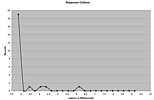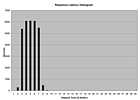Schedule November 2007
return to main 1401 Restoration Page
go to Team Bios
Contents:
Thursday November 01 - 729 tape drives
Ron Williams was there, and Ed Thelen lurked about - but no tape people showed up.
Demos at Vintage Computer Festival Saturday November 3, 2007
Wednesday November 7 - general
Plans...
Status:
Regards,
From Allen Palmer - received Monday November 5, 2007
Status ....
From John Falk - received Monday November 5, 2007
Wednesday November 14 - general
Wed November 21 - general
Ron's "far out theory" - bad brushes making sparks - spark gaps make broad band noises, might backup over an inter-record gap -
Saturday November 24 - 4th Saturday
Wednesday November 28 - general
Ron Crane has been very helpful in Circuit Breaker problems.
Ron Crane has determined that the system draws 22 amps from
this power supply,
which sounds like shaky engineering, the only excuse might be that
this is a fully "enhanced" system, far above the original concept. We decided to ask to look-at/borrow the
- 12 volt power supply from Visible Storage. In a few minutes Alex Bochannek
and Dag Spicer arrived to hear Ron Williams plead our case.
Alex was instructed to let us borrow the Visible Storage power supply, and let us return a long ago borrowed
+ 6 volt power supply. We of course promised to document and photograph the actions - as follows.
Thurs November 1 - 729 tape drives, Demos at Vintage Computer Festival
Wed November 07 - general,
Sat November 10 - 2nd Sat.
Wed November 14 - general,
Wed November 21 - general,
Sat November 24 - 4th Sat.
Wed November 28 - general,
From Bob Feretich
Beta Test of 1401 formal demos
After a number of meetings, the Vintage Computer Festival was selected to provide a test platform for
formal tours of the 1401. We have been giving informal tours and been handing out souvenir "powers of 2"
and "BIG PRINT" printouts for over a year. Dan McInnis followed the plan, and is a real pro at speaking.
Ron Williams was the 083 sorter operator and "computer operator". Ed Thelen collected visitor names and keypunched
them for the BIG PRINT program.
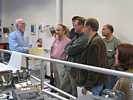
At a different VCF presentation,
Here is Lee Felsenstein, "moderator" of the old Homebrew Computer Club, and many other notable accomplishments,
Wikipedia listing.
At the Homebrew Computer Club he wielded a sizeable club as a show of authority/power
- but has seemingly mellowed since;-))

From Bob Feretich - received Sunday November 4 ,2007
I ran the test again. This time I used 80 character records.
During the test (about 25 minutes), I performed several simultaneous
downloads and C++ compiles.
The resulting distribution was even tighter than with the 496 character
record test. The worst case response time was about 5 mSec. See the
attached histogram.
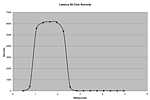
First, I need to update the driver documentation before I forget the changes.
Then, I plan to focus on the PIC firmware. Previously, I implemented a
skeleton of the needed functionality. Now I need to implement the
remainder of the message command set and the interface to the 1401 Tape
Channel. I am probably a month away from attempting to pass records
between the 1401 and PIC.
Jeff is working on the Java Daemon and Applets. The general plan is that
I will work from the top of the above list to the bottom, while Jeff
works from the bottom upward. We should meet somewhere in the middle.
Bob
Grant.
Forgot to answer this item
> ... Should we have an overall plan and recruit to it?
I ask the other team members for their ideas.
Allen j Palmer
All
Just a note about the three versions of 729's and how they were designated
RELAY, NOR and NORLAY
John
I reproduced a 250 card deck with no krinkled kards - try that again - no crinkled cards ;-))
Apparently Bob Erickson got some better rubber thingies that help push cards into the output stacker.
But neither Stan nor I could figure how to finish the job by running the last cards out of the machine.
The name of the operation is "Run Out". As soon as the machine senses no more cards in the read input hopper,
it just stops, with two cards still in the rollers :-(( Trying to cheat by depressing the input hopper
card sense switch allows one more card to go through - but then the next card station senses no card, and
stops again :-(( - So there is still a card left in the machine :-| - Like still in there right now.
Current operating rules for 80-80 reproduction of a deck
this decreases wear on the big motor generator (and saves energy)
To be polite, empty the chad box -

Stan and somebody got these breakers cleaned, (by rubbing an IBM card through the contacts while the machine was running)
and this new 083 works perfectly. (The old 083 from Germany as been removed from the 1401 restoration room -
we couldn't even get the rusty thing to feed cards reliably.

Saturday November 11 - 2nd Saturday,
This report is from Bob Erickson.
Present were (left to right) facing camera: (left picture) Bill Flora, Stan Paddock, Frank King, Joe Preston,
Mike Cheponis, Glenn Lea, | (right picture) Glenn Lea, Bob Erickson, Jeff Stutzman, Allen Palmer, Ron Williams.
Not shown, Robert Garner, Ed Thelen
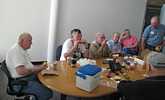
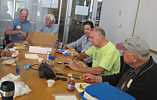
Bob Erickson and Glenn Lea made transparent cover plates for the IBM 513 summary punch.
Brown paper adheres to the plastic during shipping and working to help protect the plastic from scratches.
The plastic is fastened to the 513 using already existing holes in the 513.
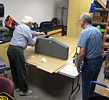

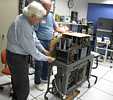
Allen and and the 729 tape drive guys are back from a summer play time building and shooting eight foot rockets.
Allen and the crew have some catching up to do.
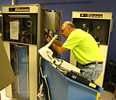
Ron Williams immortalized the summer rocketry with this statue of Allen at the firing button.
Note the rope from the rocket around Allen's foot. If that rocket goes in a hurry, so does Allen ;-))

Bill Flora and Frank King want to upgrade the lubricants we use on the equipment. The lubricants used by IBM
were modern in the 1930s, but great improvements in adhesion, wear, ... were made in the 1970s for automobiles
and aircraft. Here is Bill searching the LubriPlate web site for suitable "lubritection" replacements.
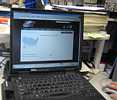
Stan Paddock is interfacing a PC to a keypunch so we can use Ron Mak's ROPE environment
and automatically keypunch object decks. He can active the hole punch magnets - now for the card release control -
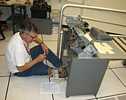
Consulting with Bob Erickson (513 in background)
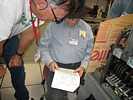
Eureka, I found it. He then ordered a USB based box controlling 24 relays ( giving 10 spares).
USB KeyPunch Preliminary Notes
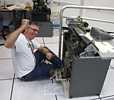
Frank King is entertaining some visitors by sorting cards at 1000/minute, about 17/second.
We have been demoing/entertaining for months. Equipment, except for tapes, works.
All anticipated software works - Powers of 2, Dan's System Exerciser, Big Print, all working for months -
as far as the team is concerned, come one, come all :-))
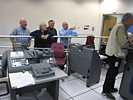
Fun & Games - Jeff Stutzman dreamed out loud of making a Tesla coil - that reminded Stan Paddock of a Ford coil test setup
in his truck -

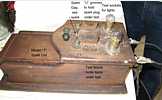
This report from Ron Williams, mostly.
Glenn & I worked today installing the new brushes in our working drive. We turn the machine on,
ran Ron's test - the one that fails most of the time - plus test decks 5000 & 5030 many times all
without failure. Not sure exactly why it ran perfectly, only time will tell. Next item it to put more
of the new brushes together and install in the other Mod V. Once they are in we will turn on power
and see what we get. Hoping for a quick bring up ( don't we always at least hope) .
allen"
This report from Ron Williams.
One of ours has the same damage but the parts are not there, angled rod (threads into something that
looks a Tee-nut (like in a furniture kit) - held in by tiny wood screws.
Van,
I got it.
JOB DIVIDE TEST
CTL 6611
*
ORG 400
* (DIVIDEN)
MILES DCW 001312 HOW MANY MILES DID YOU DRIVE?
* (DIVISOR)
GALLON DCW 13 HOW MANY GALLONS DID YOU USE?
*
BH DCW 000000 WHERE THE QUOTIENT WILL APPEAR
BL DC 000 WHERE THE REMAINDER APPEARS
*
START H
ZA MILES,BL CLEAR TO ZEROS
D GALLON,BL-6 LOW ORDER OF DIVISOR ADDRESS
* MINUS THE SIZE OF THE DIVIDEN
*
CS 299
MCW @MILES DRIVEN @,213
MCS MILES,220
MCW @GALLONS USED@,234
MCS GALLON,238
MCW @MILES PER GALLON @,260
MCS BH,277
MCW @ AND @,282
SW BL-2
MCS BL,285
CW BL-2
MCW @/@,288
MCS GALLON,295
W
DONE H START
END START
Part of 1402 Reader schematic
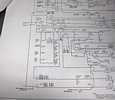
If the unit is "OFF LINE", cards will read, but give "READ CHECK"s
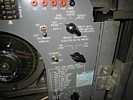

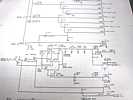
Punch die interlock - a real bear to close, even for experts !!
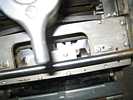
Prevents operation if hand crank inserted

Punch hopper release - somebody had played with this and the reader would not work!!
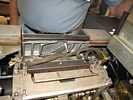
This black handle has to be up - or is it down?
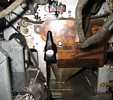


Interlock Override - pulled out is override, when door closes, the switch is pushed back and the override removed.
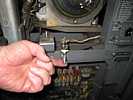
Inside left front door, and some other switch(s)??
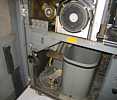
Bob Erickson feels he is on the "home stretch". Put in some missing status lamps and fix a sick startup relay
that had been jumpered to get this far.
We needed some candelabra lamps (Christmas tree style) - and had to borrow
from Ron Williams - always a chancy undertaking. Ron had decorated some for a previous project/(prank?), but beggars
can't be choosers :-((
Upper left - option switches; lower left - control relays; middle - status lamps and plugboard for reproducing with
punch check; lower right corner - a bit of the newly cleaned punch check comparitor.
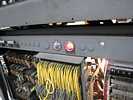
Here are Bob Erickson and Frank King examining a defective startup relay - did I hear dirty contacts??
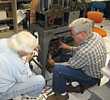
Visible Storage 1401, before November 26 change
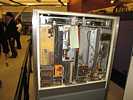
And After
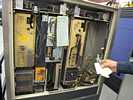
Here is the rating document on the DC circuit breaker from Visual Storage

I removed the back of the circuit breaker to see if there were any "practical" adjustment possibilities - none visible
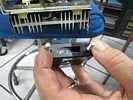
The little white paddle that appears to stick into the circuit breaker is the reporting switch to indicate
to external circuitry the position of the main switch in the circuit breaker - through the small brown, blue and black wires.
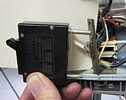
We have otherwise fixed Sellam's 026 key punch which is going to visible storage. Stan Paddock decided to fix
the two tables - two of the threaded angle rods had long since disappeared so Stan crafted two more.
Notice the liberal application of 90 second epoxy.

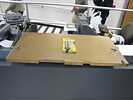

Allen and I stayed 'till about 7:30. Allen wrestling with the problem, I reading a good book - on magnetic magic.
Allen has also worked out a satisfactory recipe for showing magnetic domains on magnetic tape.
Much better than the recipe of May 26, 2007.
What is the world is going on?? The scope shows OK
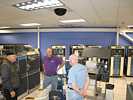
I forgot what was happening - looks worse than it was. I don't remember any of the
IBMers using any crude or blue language. (You could get fired on the spot!!)

Allen is going through the cards loaded into the computer to get the gory details of what is in the machine.
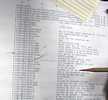
- A very little magnetic stuff (Allen says "old, used magentic from the clutches".
- Suspended in acetone - stir frequently. Fluid looks almost transparent -
- Dunk tape into fluid, Shake off excess fluid before it dries.
He was able to clearly show the 10 character records (at 200 bpi) and the long inter-record gaps caused by the
successive SKIP TAPE commands.
Glenn Lea spent many minutes trying to re-assemble something just back of the reels. This is the best picture
I got, from many angles -
I never did see what was going on-
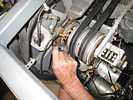
Finally gave up and took this shot.

Battery service??
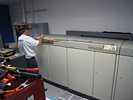
The big red handled switch on the right
was in the wrong position.
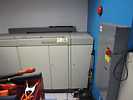
Inverter "OFF"
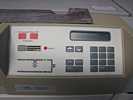
"UPS Output - 480 V, 3 PH, 60 HZ, 150 A, "
"Battery Current 275 A at 390 VDC"
that's 107.25 KW, over 140 horse power

Some of "us" think the largely unused floor mounted power distribution cabinet could be removed. Currently the only
load supplied from it (that we have found) are the key punches and work bench - which clearly don't
need a 16 square foot power distribution cabinet :-|

